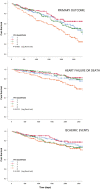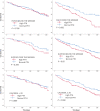Parathormone levels add prognostic ability to N-terminal pro-brain natriuretic peptide in stable coronary patients
- PMID: 33932116
- PMCID: PMC8318437
- DOI: 10.1002/ehf2.13331
Parathormone levels add prognostic ability to N-terminal pro-brain natriuretic peptide in stable coronary patients
Abstract
Aims: There are controversial data on the ability of the components of mineral metabolism (vitamin D, phosphate, parathormone [PTH], fibroblast growth factor-23 [FGF23], and klotho) to predict cardiovascular events. In addition, it is unknown whether they add any prognostic value to other well-known biomarkers.
Methods and results: In 969 stable coronary patients, we determined plasma levels of all the aforementioned components of mineral metabolism with a complete set of clinical and biochemical variables, including N-terminal pro-brain natriuretic peptide (NT-proBNP), high-sensitivity troponin I (hs-TnI), and high-sensitivity C-reactive protein. Secondary outcomes were ischaemic events (any acute coronary syndrome, stroke, or transient ischaemic attack) and heart failure or death. The primary outcome was a composite of the secondary outcomes. Median follow-up was 5.39 years. Age was 60 (52-72) years. Median glomerular filtration rate was 80.4 (65.3-93.1) mL/min/1.73 m2 . One-hundred and eighty-five patients developed the primary outcome. FGF23, PTH, hs-TnI, and NT-proBNP were directly related with the primary outcome on univariate Cox analysis, while Klotho and calcidiol were inversely related. On multivariate analysis, only PTH (HR 1.058 [CI 1.021-1.097]; P = 0.002) and NT-proBNP (HR 1.020 [CI 1.012-1.028]; P < 0.001) were independent predictors of the primary outcome but also for the secondary outcome of heart failure or death (HR 1.066 [CI 1.016-1.119]; P = 0.009 and HR 1.024 [CI 1.014-1.034]; P < 0.001, respectively). PTH was the only biomarker that predicted ischaemic events (HR 1.052 [1.010-1.096]; P = 0.016). Patients were divided in two subgroups according to FGF23 plasma levels. PTH retained its prognostic value only in patients with FGF23 levels above the median (>85.5 RU/mL) (P < 0.001) but not in patients with low FGF23 levels (P = 0.551). There was a significant interaction between FGF23 and PTH (P = 0.002). However, there was no significant interaction between PTH and both klotho and calcidiol levels.
Conclusions: Parathormone is an independent predictor of cardiovascular events in coronary patients, adding complimentary prognostic information to NT-proBNP plasma levels. This predictive value is restricted to patients with high FGF23 plasma levels. This should be considered in the design of future studies in this field.
Keywords: Coronary artery disease; Fibroblast growth factor-23; Mineral metabolism; Parathormone.
© 2021 The Authors. ESC Heart Failure published by John Wiley & Sons Ltd on behalf of European Society of Cardiology.
Conflict of interest statement
José Tuñón has given lectures for Diasorin Spain.
Figures
References
-
- Gonzalez‐Parra E, Rojas‐Rivera J, Tuñón J, Praga M, Ortiz A, Egido J. Vitamin D receptor activation and cardiovascular disease. Nephrol Dial Transplant 2012; 27: iv17‐21. - PubMed
-
- Brøndum‐Jacobsen P, Benn M, Jensen GB, Nordestgaard BG. 25‐hydroxyvitamin d levels and risk of ischemic heart disease, myocardial infarction, and early death: population‐based study and meta‐analyses of 18 and 17 studies. Arterioscler Thromb Vasc Biol 2012; 32: 2794–2802. - PubMed
-
- Parker BD, Schurgers LJ, Brandenburg VM, Christenson RH, Vermeer C, Ketteler M, Shlipak MG, Whooley MA, Ix JH. The associations of fibroblast growth factor 23 and uncarboxylated matrix Gla protein with mortality in coronary artery disease: the Heart and Soul Study. Ann Intern Med 2010; 152: 640–648. - PMC - PubMed
-
- Faul C, Amaral AP, Oskouei B, Hu M‐C, Sloan A, Isakova T, Gutiérrez OM, Aguillon‐Prada R, Lincoln J, Hare JM, Mundel P, Morales A, Scialla J, Fischer M, Soliman EZ, Chen J, Go AS, Rosas SE, Nessel L, Townsend RR, Feldman HI, St John Sutton M, Ojo A, Gadegbeku C, di Marco GS, Reuter S, Kentrup D, Tiemann K, Brand M, Hill JA, Moe OW, Kuro‐o M, Kusek JW, Keane MG, Wolf M. FGF23 induces left ventricular hypertrophy. J Clin Invest 2011; 121: 4393–4408. - PMC - PubMed
Publication types
MeSH terms
Substances
LinkOut - more resources
Full Text Sources
Research Materials



